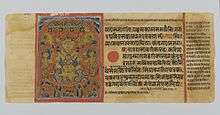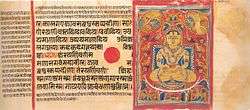Panch Kalyanaka
Panch Kalyanaka (Sanskrit: pan̄ca kalyāṇaka, "Five Auspicious Events") are the five chief auspicious events that are believed to occur in the life of tirthankara in Jainism.[1][2][3] They are commemorated as part of many Jain rituals and festivals.[4]
| Part of a series on |
| Jainism |
|---|
 |
|
Jain prayers |
|
Ethics |
|
Major sects |
|
Texts |
|
Festivals
|
|
|
Kalyanaka
These auspicious life events are as below:[3][4][5][6]
- Cyavana kalyāṇaka: When the ātman (soul) of a tirthankara enter's their mother's womb.[7]
- Janma kalyāṇaka: Birth of the tirthankara.[2][7] Snatra Puja is a ritual celebrating this event in which Indra does abhisheka on the tirthankara on Mount Meru.[8]
- Dīkṣā kalyāṇaka: When a tirthankara renounce all worldly possessions and becomes an ascetic.[9]
- Kēvalajñāna kalyāṇaka: The event when a tirthankara attains kēvalajñāna (absolute knowledge). A divine samavasarana (preaching hall) appears, from where the tirthankara delivers sermons and restores the Jain community and teachings.[10]
- Nirvāṇa kalyāṇaka: When a tirthankara leaves their mortal body, it is known as nirvana. It is followed by final liberation, moksha. A tirthankara is considered a Siddha after that.[11][12]
 Cyavana kalyāṇaka
Cyavana kalyāṇaka Janma kalyāṇaka
Janma kalyāṇaka Dīkṣā kalyāṇaka
Dīkṣā kalyāṇaka Kēvalajñāna kalyāṇaka
Kēvalajñāna kalyāṇaka Nirvāṇa kalyāṇaka
Nirvāṇa kalyāṇaka
Kalyanaka Dates of 24 Tirthankara
These dates are called Kalyanaka Tithi. All dates are considered according to Jain calendar known as Jain Panchang based on the Vira Nirvana Samvat, but they differ according to different sects of Jain tradition and sometimes different within the same tradition also.[13][14][15][16]
Note: This list is according to Śvētāmbara tradition and months are according to the Gujarati calendar.
| No. | Tirthankara | Chyavan Kalyanaka | Janma Kalyanaka | Diksha Kalyanaka | Kevala Jnana Kalyanaka | Nirvana Kalyanaka |
|---|---|---|---|---|---|---|
| 1 | Rishabha | Jeth Vad 4 | Fagan Vad 8 | Fagan Vad 8 | Maha Vad 11 | Posh Vad 13 |
| 2 | Ajitanatha | Vaisakh Sud 13 | Maha Sud 8 | Maha Sud 9 | Posh Sud 11 | Chaitra Sud 5 |
| 3 | Sambhavanatha | Fagan Sud 8 | Magsar Sud 14 | Magasar Sud 15 | Asho Vad 5 | Chaitra Sud 5 |
| 4 | Abhinandan natha | Vaisakh Sud 4 | Maha Sud 2 | Maha Sud 12 | Posh Sud 14 | Vaisakh Sud 8 |
| 5 | Sumatinatha | Shravan Sud 2 | Vaisakh Sud 8 | Vaisakh Sud 9 | Chaitra Sud 11 | Chaitra Sud 9 |
| 6 | Padmaprabha | Posh Vad 6 | Asho Vad 12 | Asho Vad 13 | Chaitra Sud 11 | Chaitra Sud 9 |
| 7 | Suparshvanatha | Shravan Vad 8 | Jeth Sud 12 | Jeth Sud 13 | Maha Vad 6 | Maha Vad 7 |
| 8 | Chandraprabha | Fagan Vad 5 | Magasar Vad 12 | Magasar Vad 13 | Maha Vad 7 | Shravan Vad 7 |
| 9 | Pushpadanta | Maha Vad 9 | Kartak Vad 5 | Kartak Vad 6 | Kartak Sud 3 | Bhadarva Sud 9 |
| 10 | Shitalanatha | Chaitra Vad 6 | Posh Vad 12 | Posh Vad 13 | Magasar Vad 14 | Chaitra Vad 2 |
| 11 | Shreyanasanatha | Vaisakh Vad 6 | Maha Vad 12 | Maha Vad 13 | Posh Vad Amaas | Ashadh Vad 3 |
| 12 | Vasupujya | Jeth Sud 9 | Maha Vad 14 | Maha Vad Amaas | Maha Sud 2 | Asadh Sud 14 |
| 13 | Vimalanatha | Vaisakh Sud 12 | Maha Sud 3 | Maha Sud 4 | Posh Sud 6 | Jeth Vad 7 |
| 14 | Anantanatha | Asadh Vad 7 | Chaitra Vad 13 | Chaitra Vad 14 | Chaitra Vad 14 | Chaitra Sud 5 |
| 15 | Dharmanatha | Vaisakh Sud 7 | Maha Sud 3 | Maha Sud 12 | Posh sud 15 | Jeth Sud 5 |
| 16 | Shantinatha | Shravan Vad 7 | Vaishakh Vad 13 | Vaiskh Vad 14 | Posh Sud 9 | Vaisakh Vad 13 |
| 17 | Kunthunatha | Asadh Vad 9 | Chaitra Vad 14 | Chaitra Vad 5 | Chaitra Vad 5 | Chaitra Vad 1 |
| 18 | Aranatha | Fagan Sud 2 | Magsar Sud 10 | Magsar Sud 11 | Kartik Sud 12 | Magsar Sud 10 |
| 19 | Māllīnātha | Fagan Sud 4 | Magsar Sud 11 | Magsar Sud 11 | Magsar Sud 11 | Fagan Sud 12 |
| 20 | Munisuvrata | Shravan Sud 15 | Vaisakh Vad 8 | Fagan Sud 12 | Shravan Vad 12 | Vaisakh Vad 9 |
| 21 | Naminatha | Asho Sud 15 | Ashadh Vad 8 | Jeth Vad 9 | Magsar Sud 11 | Chaitra Vad 10 |
| 22 | Neminatha | Asho Vad 12 | Shravan Sud 5 | Shravan Sud 6 | Bhadarva Vad Amaas | Ashadh Sud 8 |
| 23 | Parshvanatha | Fagan Vad 4 | Magsar Vad 10 | Magsar Vad 11 | Fagan Vad 4 | Shravan Sud 7 |
| 24 | Mahavira | Asadh Sud 6 | Chaitra Sud 13 | Kartak Vad 10 | Vaisakh Sud 10 | Asho Vad Amaas |
- Keys
- Dates are in short format. For example, Kartik Sud 2 means Second day of Bright half(Sud) of Kartik month.
- ^ s: according to Śvētāmbara tradition
- ^ d: according to Digambara tradition
- ^ o: according to other sources
Kalyanaka Places of 24 Tirthankara
Kalyanaka Bhumi are places where any of these Kalyanaka took place in relation to 24 Tirthankara. They are considered places of pilgrimage by Jains.[5] 20 out of 24 Tirthankaras' Nirvana kalyanaka took place at Shikharji.[12]
They are as below:[12][17][18][19][20]
| No. | Tirthankara | Chyavan Kalyanaka | Janma Kalyanaka | Diksha Kalyanaka | Keval Gyan Kalyanaka | Nirvan Kalyanaka |
|---|---|---|---|---|---|---|
| 1 | Rishabha | Ayodhya | Purimtal ( now Prayag or Allahabad) | Ashtapad | ||
| 2 | Ajitnath | Ayodhya | Shikharji | |||
| 3 | Sambhavanath | Shravasti | ||||
| 4 | Abhinandanswami | Ayodhya | ||||
| 5 | Sumatinath | |||||
| 6 | Padmaprabha | Kausambi | ||||
| 7 | Suparshvanath | Bhadaini, Varanasi | ||||
| 8 | Chandraprabha | Chandrapuri | ||||
| 9 | Suvidhinatha | Kakandi (now Khukhundu, Deoria district) | ||||
| 10 | Sheetalnath | Bhadilpur or Bhadrikapuri | ||||
| 11 | Shreyansanath | Sinhpuri, Varanasi | ||||
| 12 | Vasupujya | Champapuri (now Bhagalpur)[21] | ||||
| 13 | Vimalnath | Kampilya | Shikharji | |||
| 14 | Anantnath | Ayodhya | ||||
| 15 | Dharmanath | Ratnapuri | ||||
| 16 | Shantinath | Hastinapur | ||||
| 17 | Kunthunath | |||||
| 18 | Aranath | |||||
| 19 | Mallinath | Mithila | ||||
| 20 | Munisuvrata | Rajgruhi | ||||
| 21 | Nami Natha | Mithila | ||||
| 22 | Neminatha | Sauripur | Girnar | |||
| 23 | Parshva | Varanasi | Shikharji | |||
| 24 | Mahavira | Kundalagrama (Kshatriya Kund) near Vaishali | Rijuvalika | Pavapuri | ||
Rituals
Some rituals have close relationship with these five Kalyanakas.
Jain temple erection
When a new Jain Temple is erected, these Five Auspicious Life Events are celebrated known as Panch Kalyanak Pratishtha Mahotsava. It is followed by Anjana Shalaka, a ceremony to install new Tirthankara icon. An Acharya recite mantras related to Panch Kalyanaka followed by applying special paste to eyes of Tirthankara image. After these an icons of Tirthankara gets a status of real Tirthankara which can be worshipped by Jains. Acharya have to fast for three days before that.[22]
Worship rituals
Panch Kalyanaka Puja is a ritual solemnizes all five Kalyanaka. It was narrated by Pandit Virvijay.
Snatra Puja is a ritual related to Janma Kalyanaka in which icons of Tirthankara are bathed symbolising Indra doing Abhisheka on Tirthankara on Mount Meru after birth of Tirthankara. It performed before many other rituals and before starting of new enterprises, birthdays.[8]
Festivals
Many religious festivals mark Kalyanaka of Tirthankara especially Janma and Nirvana Kalyanaka.
Mahavir Janma Kalyanak
It marks Janma Kalyanak (birth) of 24th Tirthankara, Mahavira. Abhisheka of icons are done on this day and procession celebrating this event takes place in the cities. It is on 13th day of bright half of Chaitra month of Jain calendar (March/April).[8]
Diwali
Diwali is a day of Nirvana Kalyanaka of 24th Tirthankara, Mahavira. He attained Moksha on this day in 527 BCE. It falls on fifteenth day of dark half of Ashwin (Aaso) month (September/October) which is also a last day of a year.[8]
Pausha Dashmi
It is celebrated on 10th day of dark half of Pausha (Pushya) month of Hindu calendar(December/January). It marks Janma kalyanaka (birth) of 23rd Tirthankara, Parshvanath. Three days fast is observed by many Jains.
Maun Agiyaras
Maun Agiyaras or Ekadashi marks Kalyanaka of many Tirthankaras. It is celebrated on 11th day of Magshar month of Jain calendar (October/November). On this day, complete silence is observed and fasting is kept. Meditation is also performed.[8]
See also
| Wikimedia Commons has media related to Panch Kalyanaka. |
References
- Titze, Kurt (1998). Jainism: A Pictorial Guide to the Religion of Non-Violence. Motilal Banarsidass. p. 262. ISBN 9788120815346. Retrieved 10 December 2012.
- Jaini, Padmanabh S. (1998). The Jaina Path Of Purification. Motilal Banarsidass. pp. 196, 343, 347. ISBN 9788120815780. Retrieved 10 December 2012.
- Mehta, Jodh Sinha (1970). Abu to Udaipur: (Celestial Simla to City of Sunrise). Motilal Banarsidass Publisher. p. 20. ISBN 9788185066172. Retrieved 10 December 2012.
- Cort, John E. (2001). Jains in the World: Religious Values and Ideology in India. Oxford University Press. p. 110. ISBN 9780195132342. Retrieved 10 December 2012.
- Lal, Kanwar (1961). Holy cities of India. Asia Press. p. 59. Retrieved 10 December 2012.
- Eberhard Fischer, Jyotindra Jain (1978). Jaina Iconography, Volume 1. BRILL. pp. 4–13. ISBN 9789004052598. Retrieved 11 December 2012.
- "Chyavana Kalyanak". www.herenow4u.net. Retrieved 10 December 2012.
- Wiley, Kristi L. (2009). The A to Z of Jainism. Scarecrow Press. pp. 200, 246. ISBN 9780810868212. Retrieved 10 December 2012.
- "Diksha Kalyanak". www.herenow4u.net. Retrieved 10 December 2012.
- "Kevaljnana Kalyanak". www.herenow4u.net. Retrieved 10 December 2012.
- "Nirvana Kalyanak". www.herenow4u.net. Retrieved 10 December 2012.
- Dalal, Roshen (2010). The Religions of India: A Concise Guide to Nine Major Faiths. Penguin Books India. p. 369. ISBN 9780143415176. Retrieved 11 December 2012.
- "PANCH KALYANAK of 24 TIRTHANKAR". jainuniversity.org. Archived from the original on 10 November 2012. Retrieved 10 December 2012.
- "Kalyanak Year 2012-13". www.jain24.org. Retrieved 10 December 2012.
- "Jain Panchang 2010-Page 2" (PDF). jaindial.com/Jain_Panchang.asp. www.jaindial.com. Archived from the original (PDF) on 2 February 2014. Retrieved 10 December 2012.
- "Activity / Tithi Calendar showing Feb-2011/Posh-Maha month Kalyanaka". www.melbournejainsangh.org. Melbourne Jain Sangh. Retrieved 11 December 2012.
- "kalyanak-bhumi". jainuniversity.org. Archived from the original on 22 October 2012. Retrieved 10 December 2012.
- "Narration Chart of 24 Tirthankars". www.jainuniversity.org. Retrieved 11 December 2012.
- "Introduction 24 Tirthankaras". www.jainreligion.in. Retrieved 11 December 2012.
- "Brief details of Tirthankaras". www.ejainism.com. Retrieved 11 December 2012.
- Krishnachandra Ghosh, Puran Chand Nahar (1988). Jainism, precepts and practice, Volume 2. Caxton. p. 689. ISBN 9788185066172. Retrieved 10 December 2012.
- Jaini, Padmanabh S. (1998). The Jaina Path Of Purification. Motilal Banarsidass. pp. 196–199. ISBN 9788120815780. Retrieved 10 December 2012.